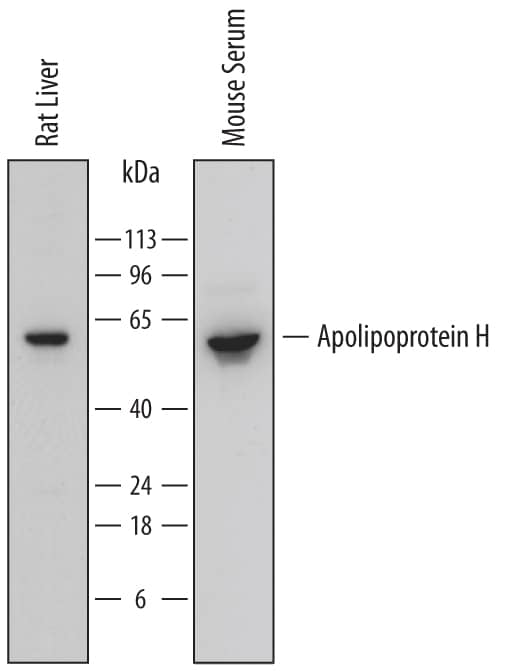Mouse/Rat Apolipoprotein H/ApoH Antibody
R&D Systems, part of Bio-Techne | Catalog # AF6575

Key Product Details
Species Reactivity
Validated:
Mouse, Rat
Cited:
Mouse
Applications
Validated:
Western Blot
Cited:
ELISA Development (Capture)
Label
Unconjugated
Antibody Source
Polyclonal Sheep IgG
Product Specifications
Immunogen
Mouse myeloma cell line NS0-derived recombinant mouse Apolipoprotein H/ApoH
Gly20-Cys345
Accession # Q01339
Gly20-Cys345
Accession # Q01339
Specificity
Detects mouse and rat Apolipoprotein H/ApoH in Western blots and detects recombinant mouse Apolipoprotein H/ApoH in direct ELISAs. In direct ELISAs, approximately 40% cross-reactivity with recombinant human Apolipoprotein H/ApoH is observed.
Clonality
Polyclonal
Host
Sheep
Isotype
IgG
Scientific Data Images for Mouse/Rat Apolipoprotein H/ApoH Antibody
Detection of Rat and Mouse Apolipoprotein H/ApoH by Western Blot.
Western blot shows lysates of rat liver tissue and mouse serum. PVDF membrane was probed with 0.25 µg/mL of Sheep Anti-Mouse/Rat Apolipoprotein H/ApoH Antigen Affinity-purified Polyclonal Antibody (Catalog # AF6575) followed by HRP-conjugated Anti-Sheep IgG Secondary Antibody (Catalog # HAF016). A specific band was detected for Apolipoprotein H/ApoH at approximately 50-60 kDa (as indicated). This experiment was conducted under reducing conditions and using Immunoblot Buffer Group 1.Applications for Mouse/Rat Apolipoprotein H/ApoH Antibody
Application
Recommended Usage
Western Blot
0.25 µg/mL
Sample: Rat liver tissue and mouse serum
Sample: Rat liver tissue and mouse serum
Formulation, Preparation, and Storage
Purification
Antigen Affinity-purified
Reconstitution
Sterile PBS to a final concentration of 0.2 mg/mL. For liquid material, refer to CoA for concentration.
Formulation
Lyophilized from a 0.2 μm filtered solution in PBS with Trehalose. *Small pack size (SP) is supplied either lyophilized or as a 0.2 µm filtered solution in PBS.
Shipping
Lyophilized product is shipped at ambient temperature. Liquid small pack size (-SP) is shipped with polar packs. Upon receipt, store immediately at the temperature recommended below.
Stability & Storage
Use a manual defrost freezer and avoid repeated freeze-thaw cycles.
- 12 months from date of receipt, -20 to -70 °C as supplied.
- 1 month, 2 to 8 °C under sterile conditions after reconstitution.
- 6 months, -20 to -70 °C under sterile conditions after reconstitution.
Background: Apolipoprotein H/ApoH
References
- Crook, M.A. et al. (2010) Atherosclerosis 209:32.
- Miyakis, S. et al. (2004) Thromb. Res. 114:335.
- Nonaka, M. et al. (1992) Genomics 13:1082.
- Lozier, J. et al. (1984) Proc. Natl. Acad. Sci. 81:3640.
- Wurm, H. (1984) Int. J. Biochem. 16:511.
- Mehdi, H. et al. (1994) J. Virol. 68:2415.
- Chonn, A. et al. (1995) J. Biol. Chem. 270:25845.
- Moestrup, S.K. et al. (1998) J. Clin. Invest. 102:902.
- Castro, A. et al. (2010) Atherosclerosis 209:201.
- Shi, T. et al. (2004) Proc. Natl. Acad. Sci. 101:3939.
- Mori, T. et al. (1996) Thromb. Haemost. 75:49.
- Hunt, J. et al. (1993) Proc. Natl. Acad. Sci. 90:2141.
- Guerin, J. et al. (2002) J. Biol. Chem. 277:2644.
- Sakai, T. et al. (2007) Am. J. Pathol. 171:1659.
- Adams, M. (2008) Semin. Thromb. Haemost. 34:251.
- Jing, X. et al. (2010) J. Cancer Res. Clin. Oncol. 16:1671.
Alternate Names
APOH, B2G1, B2GPI, Beta, BG
Gene Symbol
APOH
UniProt
Additional Apolipoprotein H/ApoH Products
Product Documents for Mouse/Rat Apolipoprotein H/ApoH Antibody
Product Specific Notices for Mouse/Rat Apolipoprotein H/ApoH Antibody
For research use only
